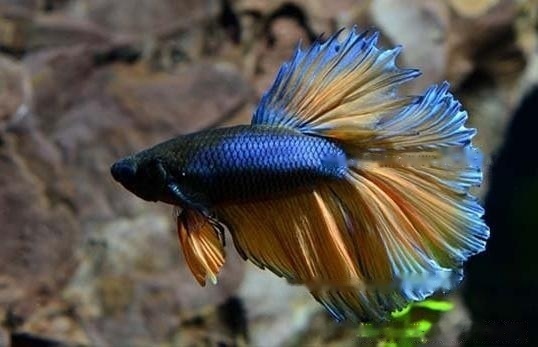Thai fighting fish, also known as Wucai fighting fish, is a perch-shaped fish native to Thailand. Thai betta species are very similar to other betta fish. They have a very strong ability to adapt to the environment, their appearance is also bright and colorful, and they are relatively simple to raise. According to the color depth of Thai betta, people have divided it into dark body and light body, and the body color of the improved Thai betta is mainly colorful single and double colors, as well as marble lines and butterfly wings. It's a bit difficult to see a single-colored betta in the aquarium market because it's relatively rare.

1. Appearance characteristics of Thai fighting fish
The body of Thai fighting fish can reach five to six centimeters in length, especially ten centimeters . Its monochromatic fish species have five colors: black, white, red, yellow and blue, while the blue and red Thai betta are more common in the aquarium market, and many aquarium enthusiasts especially like pure red. thai betta.
The male and female Thai bettas are very similar, and you can't tell them apart just by looking at them on the surface. So be sure to observe carefully, the female Thai betta has ovaries. You can look for fallopian tubes, which are the genitals of female Betta fish. If you can see small white things on the belly from the side of their body, it must be a female Betta.
2. Habits and characteristics of Thai fighting fish
Thai fighting fish is more aggressive by nature, two male Thai fighting fish meet will definitely cause war, when they fight, their fins The operculum and the operculum are open, and they use their bodies to attack each other, and then use their mouths to bite. This also reminds breeders that two adult bettas cannot be kept in the same aquarium.
The Thai betta is suitable for living in weakly acidic soft water of 22 to 24 degrees Celsius, but if the water temperature is lower than 18 degrees, it may lead to death. They like to eat live feed, and live food such as red blood worms, water fleas, and nematodes can stimulate their appetite.
3. Breeding methods of Thai betta
(1) Water quality
The suitable aquatic environment for Thai betta is in weakly acidic soft water with average water temperature It can only reach 22 degrees Celsius to 2420 degrees Celsius, and it cannot be lower than 18 degrees Celsius. If it is lower than this range, the fish are likely to freeze to death. It is necessary to change the water for the fish in the aquarium once a week to ensure that the environment in the aquarium is clean and hygienic, so that the fish will be healthier and happier during the growth process and grow better.
(2) Bait
Thai betta likes to eat live meat, such as red blood worms and water fleas. Regarding food, Thai betta also has a special food, which is a very common mosquito in life. They especially like to eat mosquitoes. If there are mosquitoes at home, they can be caught and fed, and eating more mosquitoes will greatly help the color of the Thai betta, which will make their body more colorful, and also remove pests for the home. It can be said that it kills two birds with one stone. .
(3) Polyculture
One of the biggest characteristics of Thai fighting fish is fighting, especially when two male fish meet, there must be a battle, They attack more fiercely, not only colliding with each other, but also biting with their mouths. Therefore, never keep two male bettas in the same tank, you can use two small tanks to separate them. Of course, if there is a male and a female, then there will be no such problems, but feel free to let them be together. In addition, some friends have mixed Thai fighting fish with other small tropical fish, and there is no problem of fighting.
4. Lifespan and price of Thai fighting fish
If the Thai fighting fish is below 18 degrees Celsius or above 30 degrees Celsius, it will face death, and under normal circumstances, the male fish will die. The lifespan is in the range of three to six years, while the females are only two or three years old.
The price of Thai betta varies slightly depending on size, species and region. The cheapest one is a few yuan, and one is about ten yuan, but there are also very precious display-grade fighting fish, which may be bought for hundreds of thousands of yuan.
![[Dog Training 5] The training method of pet dog dining etiquette](/static/img/12192/12192_1.jpg)




